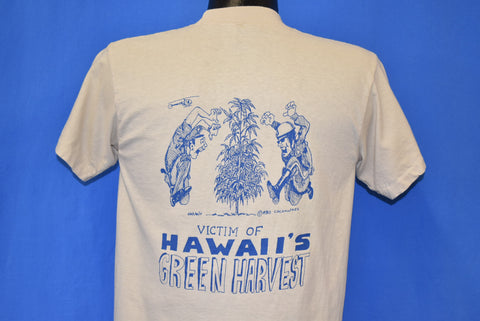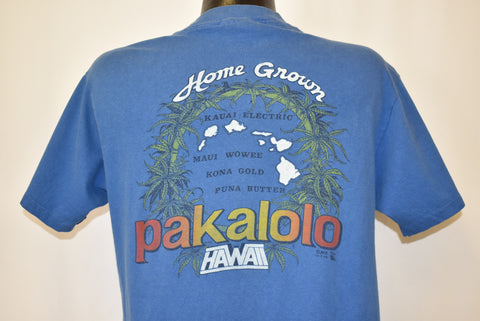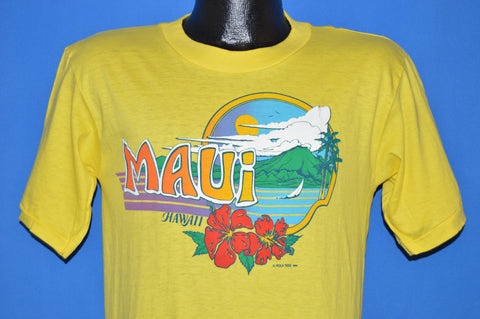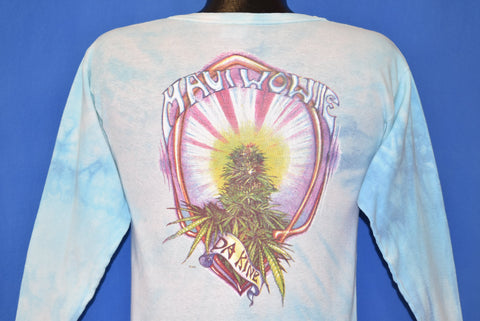This shirt is a response to the controversial Operation Green Harvest marijuana eradication program in Hawaii. As the graphic illustrates, the operation took off in the 70s as a clandestine police operation and became military raids by federal, state, and local narcotics officers in low-flying National Guard helicopters destroying marijuana crops and busting pakalolo growers. Still, pakalolo remained Hawaii’s most enduring illegal cash crop.
In Hawaii the growing conditions for cannabis plants are ideal, with a vast growing area consisting of lush wilderness and fertile valleys. "Da kine" as its called by locals, has a long history in Hawaiian culture and agriculture. When the federal government declared a military-style war on the drug, also used for medicinal and religious purposes, residents of the Big Island were not shy of expressing their opposition.
Despite the Federal Aviation Administration Regulations stating that aircraft must fly 500 feet or higher unless they have a warrant, residents recall the helicopters during Green Harvest hovering nearly 50 to 75 feet above the ground.
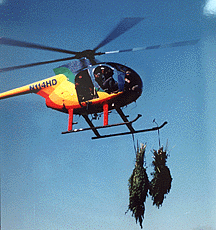
In the interest of eradicating as much of the plant as possible, Operation Wipe-Out was deployed. The mission involved these same military helicopters flying over public and private property, and releasing one of two methods for eradication; the first was spraying the plants with a toxic mixture of glyphosate herbicide, a sticking agent, and red or orange dye, and the second option was to drop men down to seize the plants forcefully.

By the 80s, eradication was a statewide operation, with most of funding coming from the federal DEA. At this time, Nancy Reagan’s “Just Say No” campaign was ushering in millions of dollars for drug enforcement. But the eradication program did little to stop cannabis cultivation, instead encouraging it by driving up the price.
Another side effect of marijuana eradication was the increase in casual drug users turning to cheaper, more damaging and addictive drugs like crystal methamphetamine, known in Hawaii as batu or ice. Green Harvest targeted sizable plots with marijuana plants of Christmas trees heights, prompting countless plots of tiny plants to emerge.
These programs gravely disrupted rural life and invaded privacy. Growers lost their homes, went to jail, and were killed over drug disputes. Noncombatant residents were routinely harassed by the helicopters for decades, ruining their peace and rattling the roof above their head and the walls around them. Meanwhile, the new plots opening up were managed by small-time dealers who knew how to avoid drug enforcement helicopters.
Residents of Hawaii opposed this war as millions of dollars were poured into it that could have been used for more pressing needs like education and healthcare.
By 1989, the cannabis industry surpassed the value of sugar, pineapple, and tourism in Hawaii. The consequences of the raids were immense. Along with the overarching war on drugs, they just made the plant more scarce and more expensive. There was never a shortage of the availability of cannabis, now being imported from California, Arizona, Oregon, Washington, and Mexico. Rates of marijuana use among Hawaii teenagers rose, forced to spend outrageous amounts for what was once a plentiful plant.
By the late 90s, they had seized more cannabis than any other state’s program. At the same time, it was estimated that Hawaii's pakalolo industry produced 250,000 pounds- ranked 5th in the country behind California, Tennessee, Kentucky, and Florida.
Named for the cities where these plants flourish, names like Puna Butter, Maui Wowee, and Kona Gold add to their mystique in marijuana lore. The common perception is that Hawaii produces the most legendary, quality pot in the country. This in part stems from cross-breeding small, quick-growing plants. But perhaps an unintended side-effect of Green Harvest and Operation Wipe-Out has been the mystification of Hawaii-grown cannabis, making it more desirable on a much larger scale.
Many shirts in our collection are a testament to this lore and its appeal to surfer, skater culture, like the graphic on this 80s tee, emblazoned with, "Killer Buds."
Or this shirt presenting the plant as a spiritual, holy entity.
An even larger portion of our collection consists of vintage tourist t-shirts from Hawaii. Noticeable threads in these souvenirs include images of the ocean, the sun, palm trees, and tropical flowers. Together, the islands are conveyed as paradise itself. But the price for this image comes at the cost of the residents of Hawaii, whose homes were raided to maintain the perception of a family-friendly paradise the tourism industry relies on.
More recently, an ironic plot twist on Green Harvest surfaced. A helicopter pilot who spent over three decades working with Hawaii's Domestic Cannabis Eradication Program proposed to open his own dispensary under the name of Grateful Meds.
In 2019 Hawaii decriminalized marijuana. However, its legalization has failed to gain serious traction in its legislature.
Shop our collection of vintage Hawaii tourist t-shirts here.

